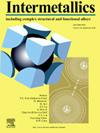A designed FeCoNiCuTiV high-entropy filler metal toward achieving superior interfacial bonding Ti2AlNb alloy
IF 4.8
2区 材料科学
Q2 CHEMISTRY, PHYSICAL
引用次数: 0
Abstract
As a critical material of next-generation aircraft, joining Ti2AlNb alloy has emerged as a key in demanding structural applications. Herein, a novel FeCoNiCuTiV high-entropy filler metal was designed for vacuum brazing of Ti2AlNb alloy, inhibiting the formation of continuous brittle intermetallic compounds (IMCs) due to the role of high mixing entropy. Typical interfacial microstructure of the brazed joint was Ti2AlNb/B2 + (Ti, Nb)3Al/Ti2AlNb phase dissolved with Fe, Co, Ni and Cu + Ti3Al + (Ti, Nb)3Al + Nb2Al + Ti-rich IMC/B2 + (Ti, Nb)3Al/Ti2AlNb. The dissolution of the Ti2AlNb alloy induced the formation of the Nb2Al phase at the interface under excessive brazing temperature, leading to the destruction of the high-entropy system of the filler metal. Elevated brazing temperature promoted the uniformity of the brazing seam microstructure and eliminated the residual brazing zone. The maximum strength of 235.9 MPa was reached at 1150 °C for 10 min. Nanoindentation and fracture path revealed that the diffusion zone was the weak zone of the joint and that the formation of (Ti, Nb)3Al phase perpendicular to the interface contributed to the strength of the joint. The fracture mode of the joint was a brittle fracture with cleavage fracture characteristics. This work shed light on opening up a wider field of high-entropy alloys as filler metals, which also provided references for accelerating the practical applications of the Ti2AlNb alloy.

设计了一种FeCoNiCuTiV高熵填充金属,用于实现Ti2AlNb合金的良好界面结合
作为下一代飞机的关键材料,加入Ti2AlNb合金已成为要求苛刻的结构应用的关键。本文设计了一种新型FeCoNiCuTiV高熵填充金属,用于Ti2AlNb合金的真空钎焊,由于高混合熵的作用,抑制了连续脆性金属间化合物(IMCs)的形成。钎焊接头典型的界面组织为Ti2AlNb/B2 + (Ti, Nb)3Al/Ti2AlNb相,与Fe、Co、Ni、Cu + Ti3Al + (Ti, Nb)3Al + Nb2Al +富Ti的IMC/B2 + (Ti, Nb)3Al/Ti2AlNb相溶。在过高的钎焊温度下,Ti2AlNb合金的溶解导致界面处Nb2Al相的形成,导致填充金属高熵系统的破坏。提高钎焊温度促进了焊缝组织的均匀性,消除了残余钎焊区。在1150℃下保温10 min,最大强度达到235.9 MPa。纳米压痕和断裂路径表明,扩散区是接头的薄弱区,垂直于界面的(Ti, Nb)3Al相的形成有助于接头强度的提高。接头断裂方式为具有解理断裂特征的脆性断裂。本研究为进一步开拓高熵合金作为填充金属的广阔领域提供了启示,也为加速Ti2AlNb合金的实际应用提供了参考。
本文章由计算机程序翻译,如有差异,请以英文原文为准。
求助全文
约1分钟内获得全文
求助全文
来源期刊

Intermetallics
工程技术-材料科学:综合
CiteScore
7.80
自引率
9.10%
发文量
291
审稿时长
37 days
期刊介绍:
This journal is a platform for publishing innovative research and overviews for advancing our understanding of the structure, property, and functionality of complex metallic alloys, including intermetallics, metallic glasses, and high entropy alloys.
The journal reports the science and engineering of metallic materials in the following aspects:
Theories and experiments which address the relationship between property and structure in all length scales.
Physical modeling and numerical simulations which provide a comprehensive understanding of experimental observations.
Stimulated methodologies to characterize the structure and chemistry of materials that correlate the properties.
Technological applications resulting from the understanding of property-structure relationship in materials.
Novel and cutting-edge results warranting rapid communication.
The journal also publishes special issues on selected topics and overviews by invitation only.
 求助内容:
求助内容: 应助结果提醒方式:
应助结果提醒方式:


